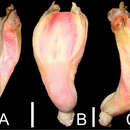Distribution
(
الإنجليزية
)
المقدمة من Zookeys
The Tupinambis specimens available in Brazilian collections were examined together with the eight Tupinambis quadrilineatus specimens collected during the present study, in Maranhão and Piauí (Figure 2). The localities reported here represent the northernmost known records of Tupinambis quadrilineatus, and extend the known distribution of the species at least 500 km from the nearest locality, in Balsas, Maranhão (Barreto et al. 2007). This is the northernmost record of the occurrence of the species.
Five Tupinambis quadrilineatus specimens were examined in the collection of the Goeldi Museum. In 1993, specimen MPEG 16817 was collected in Balsas, Maranhão (reported by Barreto et al. 2007), and specimen MPEG 16845 was captured in the municipality of Lagoa Alegre, Piauí. In 2009, three specimens were collected during the Parnaiba Project in Ribeiro Gonçalves (MPEG 30139), and Uruçuí (MPEG 30141), in the state of Piauí, and São Raimundo das Mangabeiras (MPEG 30140), in Maranhão.
The herpetological collection of the Universidade Federal do Piauí provided specimens or records of Tupinambis quadrilineatus from a number of sites in Piauí. Specimen CHNUFPI 0036 (Figure 3A) was collected in 2010 in the Palmares National Forest (05°02'55"S, 42°35'59"W, SAD69), in the municipality of Altos. The vegetation of this area is semi-deciduous tropical forest typical of the Cerrado, an ecotonal region between Cerrado and Amazonia biomes, similar to that found in Lagoa Alegre. Tupinambis quadrilineatus occurs in syntopy with Salvator merianae in this area, as recorded at a number of other sites (Colli et al. 1998, Silveira 2009). Also in 2010, a roadkilled specimen of Tupinambis quadrilineatus (CHNUFPI 0037) was collected in the municipality of Monsenhor Gil (05°39'56"S, 42°35'28"W, SAD69). In May 2011, the third and final Tupinambis quadrilineatus specimen held in the collection (CHNUFPI 0038; Figure 3B–D) was collected in a pitfall trap installed in the vicinity of a small stream within an area dominated by Cerrado savanna (sensu strictu) in the municipality of Guadalupe (05°2'55"S, 42°35'59"W, SAD69). Two other specimens were observed in the municipality of Amarante (06°14'43"S, 42°46'46"W and 06°2'1"S, 43°3'40"W, SAD69) in 2009 and 2011, but specimens were not collected. In this area, the vegetation was dominated by secondary semi-deciduous tropical forest, mixed with patches of Cerrado sensu strictu.
These findings expand the geographic distribution of Tupinambis quadrilineatus is northwards, and encompass the the region between the states of Piauí and Maranhão, which is dominated by Cerrado sensu strictu and/or forested patches of the Cerrado–Amazon ecotone. In this region, Tupinambis quadrilineatus also occurs in syntopy with Salvator merianae, which was previously classified as a member of the genus Tupinambis.
- ترخيص
- cc-by-3.0
- حقوق النشر
- Marcélia Basto da Silva, Geraldo Rodrigues de Lima-Filho, Áurea Aguiar Cronemberger, Leonardo Sousa Carvalho, Paulo Roberto Manzani, Jânia Brito Vieira
- الاقتباس الببليوغرافي
- da Silva M, de Lima-Filho G, Cronemberger , Carvalho L, Manzani P, Vieira J (2013) Description of the hemipenial morphology of Tupinambis quadrilineatus Manzani and Abe, 1997 (Squamata, Teiidae) and new records from Piauí, Brazil ZooKeys 361: 61–72
- مؤلف
- Marcélia Basto da Silva
- مؤلف
- Geraldo Rodrigues de Lima-Filho
- مؤلف
- Áurea Aguiar Cronemberger
- مؤلف
- Leonardo Sousa Carvalho
- مؤلف
- Paulo Roberto Manzani
- مؤلف
- Jânia Brito Vieira

